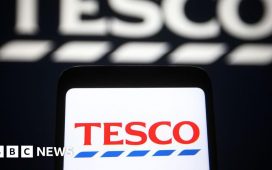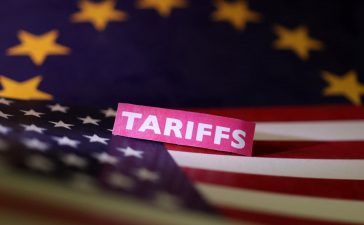On October 26, 2022, the world’s richest man Elon Musk carried a large porcelain kitchen fixture into Twitter’s San Francisco headquarters.
‘Let that sink in,’ he famously tweeted, after showing up to work with an actual sink and announcing that he was the new owner of Twitter.
Now, after 12 rollercoaster months, the impact of his decision has definitely sunk in.
Musk was already a huge social media star when he decided to buy Twitter in April 2022, beginning a complex acquisition process. He tried to pull out after claiming the social network had failed to crack down on spambots – automated accounts which mimic human profiles in order to spread content on social media – but a judge forced him to go through with the $44 billion sale.
Then he moved quickly, sacking senior staff including former CEO Parag Agrawal and starting a long series of layoffs in which employees were fired by email and others were given their marching orders after criticising the Tesla and SpaceX founder on Twitter.
What came next was a dramatic overhaul of the social network, scrapping the blue tick and replacing it with a paid scheme in which users could verify their account starting at £9.60 a month.
It was the first salvo in a string of sometimes controversial updates which included a bid to limit the number of tweets users could view in one day.
By September 2023, Musk was suggesting all users would have to pay to access his social network, and earlier this week began charging new users in New Zealand and the Philippines $1 a year for basic accounts.
However, perhaps the most talked-about update came in July, when he decided to scrap the name Twitter and rename his social network X – leaving users confused about what to call tweets in the billionaire’s brave new world.
It also gave way to the photo opp of paparazzi’s dreams when Musk stopped traffic to pull down the old Twitter sign from its San Francisco HQ, which at one point with the sign half removed, only the words ‘twit’ and ‘er’ were left visible.
The awkward juxtaposition served as a neat visual representation of the incredulous reaction sparked by his decision to rebrand Twitter – a much-loved and iconic social network famed for its blue bird and ‘fail whale’ icons.
Reflecting on the last 12 months of Elon’s Twitter takeover, Dr Annmarie Hanlon, senior lecturer in digital and social media marketing at Cranfield School of Management, tells Metro.co.uk how Twitter was once ‘the breaking news channel and a place you could hear a wide range of opinions’.
However, she warns that the platform’s future now looks ‘increasingly uncertain and volatile’ and calls on the billionaire to ‘build the community rather than destroy it’.
‘For many the hasty rebrand to “X” left the platform with a malevolent and uninviting aesthetic,’ she continued.
‘Some regard its appearance as a force for bad, instead of an intended force for good. Musk’s takeover of Twitter has profoundly impacted user experience, namely through a surge in hate speech, misinformation, and bots across the platform.
‘Restoring civility and trust should be his top priority. Users and brands want a safe, constructive platform.’
Free speech zone or ‘cesspit’ of hate and misinformation?
Just a few weeks after buying Twitter, Musk asked users to vote on whether there should be an ‘amnesty’ for people who had been banned from the site, as long as they were not spammers or had broken the law. After the vote, he then allowed figures such as Kanye West, Andrew Tate, Donald Trump and the far-right extremist Nick Fuentes back onto the platform.
It was a move that prompted outcry from many campaigners who claim that hate speech has proliferated on Twitter and X over the last 12 months.
At the end of 2022, analysts from the Centre for Countering Digital Hate (CCDH) alleged that the number of tweets containing the n-word had tripled since Musk’s takeover. However, Musk claimed the opposite was true and that hate speech had been reduced on his watch. His company X Corp is now suing CCDH, claiming it cost the platform ‘tens of millions of dollars’ in advertising revenue. CCDH did not respond to our requests for further comment.
The fault lines of the free speech debate were never more obvious following Hamas terrorists’ attack on Israel earlier this month, prompting the EU to open a formal investigation into X in relation to the spread of ‘terrorist and violent content’ relating to the conflict – and disinformation.
Again, Musk questioned the allegations and wrote: ‘Our policy is that everything is open source and transparent, an approach that I know the EU supports. Please list the violations you allude to on X, so that that [sic] the public can see them.
‘Merci beaucoup.’
Linda Yaccarino, appointed CEO of X in May after Musk posted a poll asking if he should step down, did provide a more comprehensive response.
Following the attacks, Countdown maths whizz Rachel Riley posted: ‘Twitter is a cesspit, even worse than before Musk took over.’
However, Musk still has many supporters who back his crusade for free speech.
On the day of Hamas’s attack, Dominic Cummings, Brexit architect and grand vizier to Boris Johnson, posted: ‘Today reminds me how happy I am @ElonMusk bought Twitter – if you look at mainstream news, including BBC, you see censorship and propaganda everywhere to limit damage to Hamas.’
Metro.co.uk approached Cummings for comment but he did not respond.
Michael Fertik, a well-known Silicon Valley venture investor who is the founder and managing director of venture capital firm Heroic Ventures, tells Metro.co.uk: ‘The question is not whether Elon has run Twitter and X better than an armchair commentator on X would have done. It’s whether he ran it better than the apparently self-unaware woke junta did before he bought it.
‘The answer is, so far, a resounding yes.
‘Freer speech is winning again. And economically, he had the guts to reduce an obviously enormously bloated staff, which loss-making companies should probably do more often. I don’t love all of his off-the-cuff “philosophy”, but probably neither does he, after sleeping on it.’
The future for Twitter
Ever since the Musk takeover, his political and ideological opponents have threatened to leave X and sign up to other platforms, such as Mastodon. Mark Zuckerberg even launched a Twitter competitor, Threads, which does not appear to have been the success its founder hoped for.
So far, the expected exodus has not taken place. In June 2023, Musk posted figures showing that the number of monthly users of X had reached a ‘new high’ and soared to more than 540 million.
Recent figures from the analytics and business intelligence firm GWS revealed that X’s average daily user numbers have ‘remained steady’ in both the US and UK since early July. It continues to average around 22 million active users each day in the US and 6 million active users each day in the UK. Daily active users of Meta’s Threads have ‘fallen significantly’ in both markets.
Dr Paul Carter, CEO of GWS, tells Metro: ‘Elon Musk’s major overhaul of Twitter’s branding, adopting the X name and logo, might have attracted controversy, especially at a time when the company faces the looming threat of a well-funded rival in Threads.
‘However, real-time mobile data from social media users across the UK and the US shows Twitter continues to hold steady despite external threats.
‘The same, however, cannot be said for its main new rival Threads and its parent company Meta. The mass exodus from one platform to the other just hasn’t occurred.’
Dr Alex Gunz, lecturer in marketing at Alliance Manchester Business School, said Twitter is protected from competition by a phenomenon known as a ‘network lock-in’ effect.
‘The most valuable aspect about social media platforms is the fact that everyone else is there too,’ he says. ‘This herd effect seems to have helped Twitter to stay afloat since Musk’s takeover. Membership has shrunk somewhat, but the exodus never hit a critical mass.’
This situation could change if enough people decide to jump ship and move to a different social network.
‘If enough users are dissatisfied with Twitter and turn to a sufficiently plausible alternative, then the trickle of migration could well hit a tipping point,’ Dr Gunz continued. ‘If enough people move to a new place, then the lock-in goes with them, and so does Twitter’s monopoly.’
Although the user base has not yet deserted X, it faces ‘a significant challenge when it comes to attracting and retaining users’, Arden University’s Dr Syed Tarek tells Metro.
‘With Elon Musk’s recent approach of prioritising blue tick subscribers over ads, it’s possible that many non-subscribers, who are responsible for creating and consuming the majority of the platform’s content, may feel alienated,’ says Dr Tarek, deputy head of school of leadership and management at the private university.
‘It seems that X users are actively seeking alternatives, but it’s likely that the platform will experience a gradual decline rather than a sudden collapse. There’s a clear need for other platforms to catch up to Twitter’s capabilities before users commit to the switch for the long-term.’
Is there trouble ahead for X?
While Elon wants to turn X into a ‘super app’ – the name of ‘one app to rule them all’ services like WeChat in China, which enables users to do everything from sharing photos to making payments – the road ahead looks far from smooth for the social media site.
Kirsty Minns, executive creative director and partner at Mother Design, tells Metro.co.uk that Elon’s unique management style poses its own risks.
‘He appears to be using the same “break it til you make it” playbook seen in the early days of both Tesla and SpaceX – but the big problem is that this playbook applies to start-ups, not a globally recognised brand with an already established set of values,’ she says.
‘Twitter already meant something to people, they’d given it a purpose. Now, it appears that users are not at the centre of the brand and Musk has total freedom to do what he likes, without any accountability”.
A hint of a potential challenge ahead came in August 2023, when Musk announced plans to collect and store users’ biometric data for safety, security and identification purposes.
Alex Laurie, SVP at the digital identity platform ForgeRock, told Metro.co.uk about one example of a potential problem which could push users into moving to another social network. He said that a ‘subtle change’ to X’s privacy policy like this suggests Elon Musk is capable of ‘acting on whims without thinking things through’.
Laurie says: ‘This could cause serious revenue issues for X as our own research, conducted earlier this year, shows that 44% of UK users would stop using X if it implemented a requirement for identity verification. Given existing consumer distrust of social media companies, especially when handling credentials and online identities, we may witness an acceleration in user drop-off if X implements this decision.’
The biometric data issue is just one example of the many challenges Musk faces as he strives to build the first super app in the West.
As we move into the second year of Musk’s ownership of X, little is certain about its future and it is more or less impossible to predict the plans of its owner.
‘What’s next?’ Olivia Wedderburn, executive social influence director at TMW Unlimited, a creative agency based in London, tells Metro. ‘It’s hard to say, but my bet is in the cold hard ground.’
MORE : Musk’s Twitter is the biggest source of fake news, warns EU official
MORE : Elon Musk’s latest change to Twitter/X is his most radical yet
MORE : Richest man in the world Elon Musk’s biography tells 14 surprising tales
Follow Metro across our social channels, on Facebook, Twitter and Instagram
Share your views in the comments below
Get your need-to-know
latest news, feel-good stories, analysis and more
This site is protected by reCAPTCHA and the Google Privacy Policy and Terms of Service apply.



















